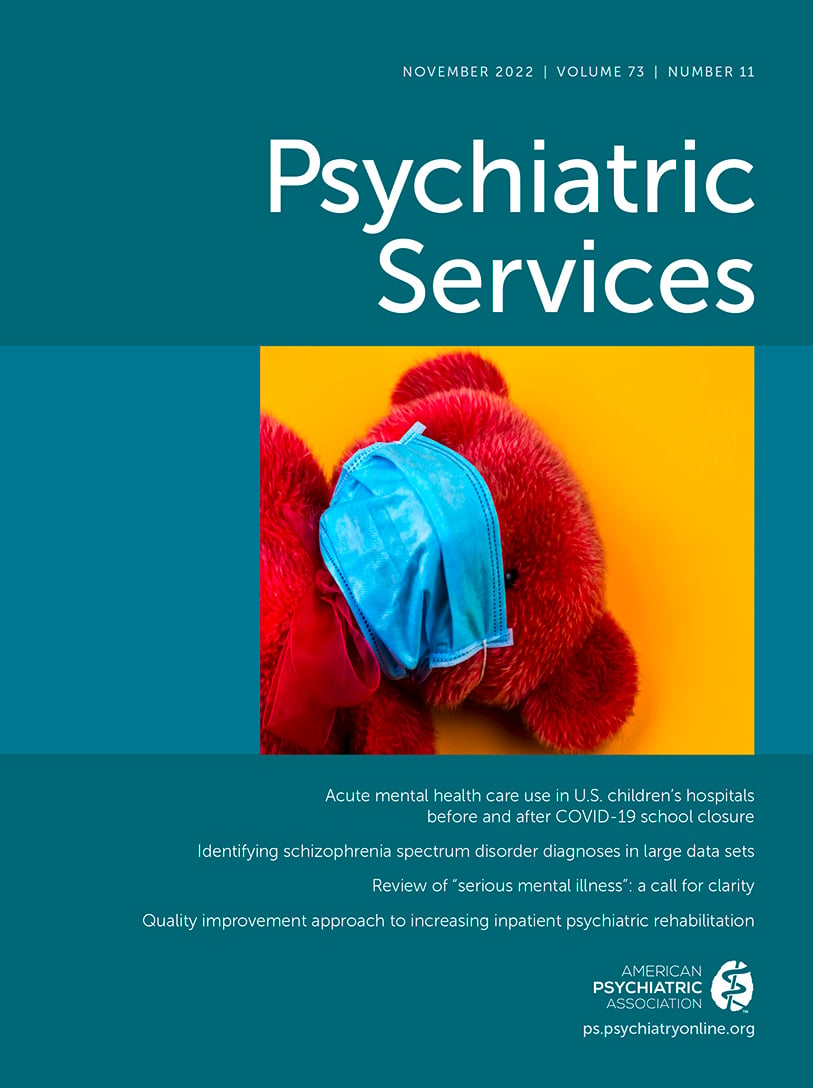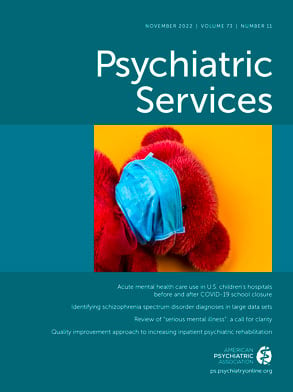A Recovery-Oriented Intervention for People With Psychosis: A Pilot Randomized Controlled Trial
Abstract
Objective:
Methods:
Results:
Conclusions:
HIGHLIGHTS
Methods
Settings
Recruitment and Consent
Randomization
Intervention
CTI-TS.
Usual care.
Assessments
Outcomes.
Baseline characteristics.
Fidelity.
Sample Size
Data Analysis Plan
Ethical Considerations
Results
Baseline Characteristics
| CTI-TS | Usual care | ||||||
|---|---|---|---|---|---|---|---|
| Characteristic | N | % | N | % | χ2 | df | p |
| Clinical | |||||||
| Diagnosis | 1.36 | 1 | .24 | ||||
| Nonaffective psychosis | 30 | 45 | 36 | 55 | |||
| Affective psychosis | 25 | 57 | 19 | 43 | |||
| Course type | 1.41 | 2 | .49 | ||||
| Continuous | 16 | 41 | 23 | 59 | |||
| Episodic | 26 | 53 | 23 | 47 | |||
| Other | 13 | 59 | 9 | 41 | |||
| Sociodemographic | |||||||
| Age | .93 | 3 | .82 | ||||
| 21–29 | 13 | 50 | 13 | 50 | |||
| 30–39 | 16 | 57 | 12 | 43 | |||
| 40–49 | 14 | 48 | 15 | 52 | |||
| 50–65 | 12 | 44 | 15 | 56 | |||
| Gender | .04 | 1 | .85 | ||||
| Female | 25 | 51 | 24 | 49 | |||
| Male | 30 | 49 | 31 | 51 | |||
| Education | 4.38 | 3 | .22 | ||||
| No school or incomplete | 20 | 47 | 23 | 53 | |||
| Some high school | 4 | 29 | 10 | 71 | |||
| High school graduate | 17 | 55 | 14 | 45 | |||
| More than high school | 12 | 63 | 7 | 37 | |||
| Missing | 2 | 67 | 1 | 33 | |||
| Living situation | .36 | 3 | .95 | ||||
| Living alone | 9 | 45 | 11 | 55 | |||
| Living with spouse/partner | 11 | 50 | 11 | 50 | |||
| Living with family | 31 | 51 | 30 | 49 | |||
| Other living situation | 4 | 57 | 3 | 43 | |||
| Employment | 2.57 | 3 | .46 | ||||
| Employed | 8 | 40 | 12 | 60 | |||
| Occasional work | 11 | 65 | 6 | 35 | |||
| Retired/pensioner | 6 | 43 | 8 | 57 | |||
| Unemployed | 30 | 51 | 29 | 49 | |||
The 18-Month Follow-up
Primary Outcomes: Quality of Life and Unmet Needs
| Unadjusted | Fully adjusted | |||||
|---|---|---|---|---|---|---|
| Measure | Estimateb | 95% CI | p | Estimatec | 95% CI | p |
| WHOQOL-BREF | ||||||
| How would you rate your quality of life? | .07 | −.98 to .99 | .990 | .12 | −.14 to .39 | .365 |
| How satisfied are you with your health? | .11 | −.71 to .92 | .790 | −.06 | −.13 to .01 | .104 |
| Domain | ||||||
| Physical health | −3.9 | −44.2 to 36.3 | .848 | .20 | −4.3 to 4.7 | .930 |
| Psychological health | −1.9 | −41.1 to 44.9 | .929 | 1.43 | −6.6 to 9.4 | .726 |
| Social relationships | −3.8 | −45.6 to 53.3 | .880 | 2.05 | −5.4 to 9.5 | .590 |
| Environmental health | −5.9 | −39.9 to 28.1 | .733 | 1.34 | −3.5 to 6.2 | .585 |
| Recreation | −2.8 | −37.5 to 31.9 | .872 | .15 | −11.3 to 11.6 | .979 |
| CAN mean totald | .05 | −.39 to .51 | .815 | .24 | −.05 to .51 | .103 |
Sensitivity Analysis
Further Exploratory Analysis
Fidelity
Discussion
Conclusions
Supplementary Material
- View/Download
- 371.25 KB
References
Information & Authors
Information
Published In
History
Keywords
Authors
Competing Interests
Funding Information
Metrics & Citations
Metrics
Citations
Export Citations
If you have the appropriate software installed, you can download article citation data to the citation manager of your choice. Simply select your manager software from the list below and click Download.
For more information or tips please see 'Downloading to a citation manager' in the Help menu.
View Options
View options
PDF/EPUB
View PDF/EPUBLogin options
Already a subscriber? Access your subscription through your login credentials or your institution for full access to this article.
Personal login Institutional Login Open Athens loginNot a subscriber?
PsychiatryOnline subscription options offer access to the DSM-5-TR® library, books, journals, CME, and patient resources. This all-in-one virtual library provides psychiatrists and mental health professionals with key resources for diagnosis, treatment, research, and professional development.
Need more help? PsychiatryOnline Customer Service may be reached by emailing [email protected] or by calling 800-368-5777 (in the U.S.) or 703-907-7322 (outside the U.S.).

